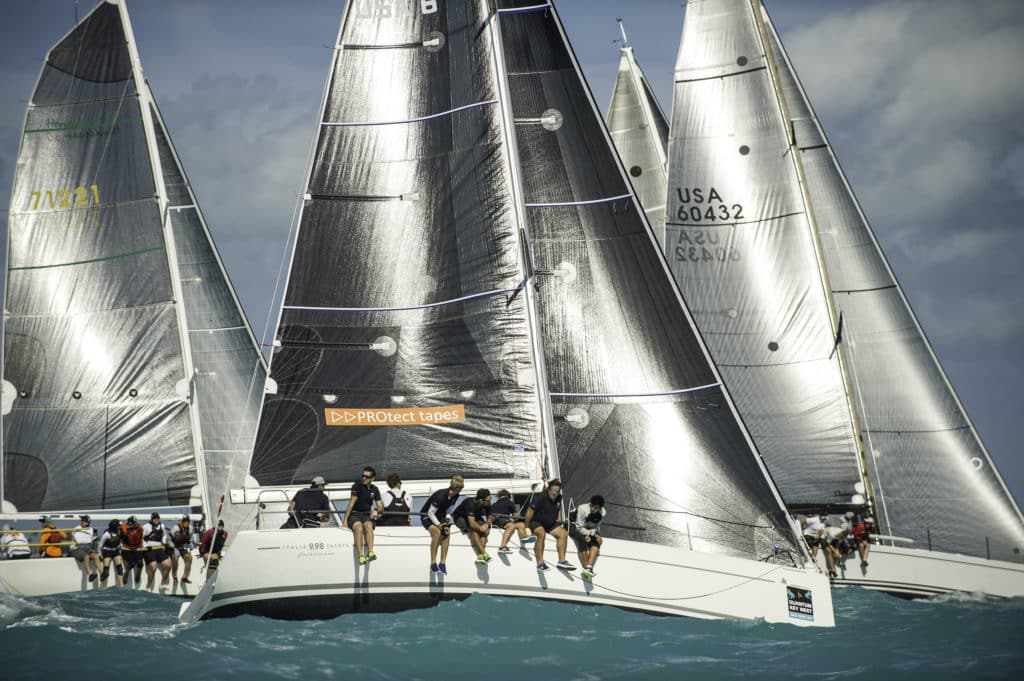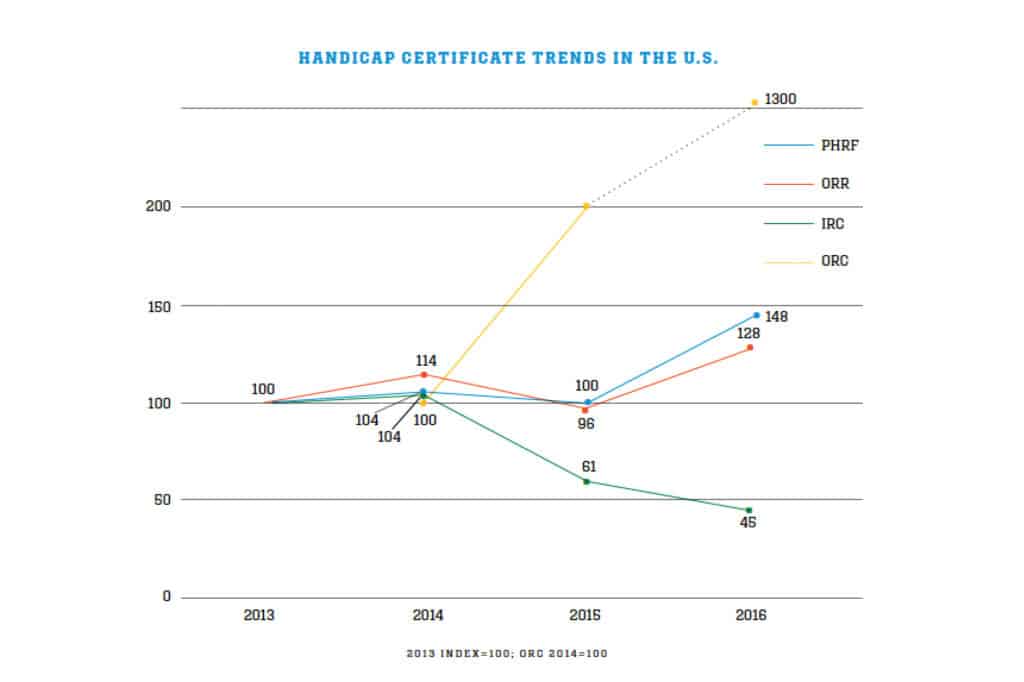
In the ’70s and ’80s, if you were keen to race your cruising boat, PHRF was the handicap rule of choice. For furniture-laden production boats saddled with performance compromises, PHRF was an easy gateway into competitive sailing. There were also designers and custom builders devising faster and leaner boats for owners wanting to compete at a higher level. IOR was their racing fleet. It was a technical rule, used internationally, which allowed owners to compete on the world stage. In the heydays, top IOR teams had global respect. This two-tiered rating rule hierarchy essentially remains the model in most countries today: There’s a gateway rule and a technical rule. Not so in the United States.
While PHRF serves the vast majority of local handicap racers, American owners now have a shopping list of more-technical options — IRC, ORC and ORR — none of which are compelling enough to outwit the other. Having too many options is negatively impacting participation. Handicap fleets need tiers of competition, providing a ladder for owners and teams to climb and find their appropriate level. Local, regional, national, and international steps create inspiration and motivation. A unified rule fosters confidence with owners and provides direction to designers and builders, encouraging them to invest in the development of new boats and equipment. I see this in other countries where there’s a commitment to a technical rule, but not so much in the United States. Without a compelling reason to invest in racing programs, we instead see older boats with handy age allowances focused on local and regional sailing.
Lacking high-level big-boat handicap racing, many of these same people have joined smaller keelboat one-design fleets, bringing their grand-prix budgets into the Corinthian realm. My dad had boats in the 25-foot range, contending he could race at a high level without being outspent. Today, he says, that wouldn’t be the case. With fleet numbers in decline since the 1980s, PHRF has become the catch-all. “We have seen some drop at the top end but a significant drop in participation in recent years of the midlevel racers,” says Bruce Bingham, chair of the U.S. PHRF Committee. “We know boats are still out there because owners dutifully get certificates each year, but maybe race one or two of their favorite regattas instead of all season long.” Bingham says the lack of a uniformly accepted high-level measurement rule is negative impacting PHRF. “It is too much to ask of PHRF to support a mixed fleet across all skill levels in the same class,” says Bingham. “PHRF was never intended to rate the top end of the fleet where thousands of dollars (or more) are spent to gain a few seconds per mile.”
To help bridge the rating rules, the idea was born for a universal measurement system, which would allow a boat to be measured once. A boat’s measurement data could be applied across all technical rating rules. Implementation of the UMS took some doing, as IRC, ORC and ORR each have unique measurement protocols. The advantage of UMS, however, is that a boat measured in England, where IRC is most prevalent, could now readily compete in the Mediterranean, where ORC is prominent. I’m not convinced UMS is progress for the United States. Each rating rule is complicated, and people like familiarity. As long as all three rules remain on the table, owners will advocate for what is better for their boat. UMS is a good solution for an international problem, but I fear it will only hasten the headway we really need, which is toward a unified national rule.
Dual scoring is another attempt to encourage participation, offering multiple options for entry so owners enjoy their preferred rule. The practice of entering a race under more than one rule, however, often leads to inconsistent results. Winners under one rule often find themselves down the ranks in another, scattering the spotlight and turning trophies into participation awards. Is there a sensible reason for the existence of three technical rules?
“That is a tough question,” says Bjorn R. Johnson, executive director of Offshore Racing Association, which owns and manages ORR. “It all depends from where you sit in the grand scheme of things. Having raced and campaigned many of my own boats, I have seen the diversity of the rating systems firsthand. In the States, we have a capitalist economy and that allows us to have choices and make our own decisions.”

James Dadd, director of the RORC Rating Office for IRC, is succinct: “No one needs lots of rating rules. Racing should be about getting out there, enjoying yourself and chatting at the bar about what you got right or wrong, and not about the rule.” ORC, the latest rule to the menu, arrived in the United States by invitation, says Dobbs Davis, Communications Director for ORC. “There are fleets dissatisfied with other options for many reasons, whether it’s being too subjective, not responsive enough to measurement and certification, not transparent in process or development, not confident of the accuracy of the ratings, too expensive, et cetera.”
Each rule makes a compelling case. IRC, which is managed by British and French authorities, is the widest geographically spread rating rule recognized by World Sailing. “Looking at the results we see around the world, I would suggest it works well as both an inshore rule and an offshore rule,” says Dadd. “Notably, it’s the principle system used in every offshore race around the world outside the United States.”
ORC, headquartered in Italy, has had the benefit of being the designated rule with a world championship. “ORC championship events such as the Worlds, Europeans and Sportboat Europeans continue to attract record entries,” says Davis, noting the rule’s usage in more than 40 countries. “There were 131 at the Worlds, 78 at the Europeans, and 40 at the Sportboats. Bids for these events extend out as far as 2020, demonstrating a strong demand.”
What IRC and ORC have are numbers. Participation ensures these rules are self-sustaining and able to invest in the technical tools needed to effectively rate boats. As international rules, U.S. boats can readily compete abroad, but perhaps more important, they allow foreign teams to compete in the States. Quantum Key West Race Week, for example, sees its use of ORC as a means to encourage international entrants.
ORR, on the other hand, has yet to cast its net beyond North American waters. This has limited overall participation, and while the sale of their products and agreements represents the major parts of the business model and provides general financial support, the rule does look for interested donors or sponsors to fund research and development and for educational projects.
ORR’s strength stems from its founding clubs — the Chicago YC, the Cruising Club of America and the Transpacific YC — which joined forces in an effort that led to the development and administration of the rule. These clubs use ORR in their signature events — Chicago Mackinac Race, Newport Bermuda Race and Transpac Race — which have fostered growth in those regions.
“ORR now extends far beyond the events of its founders with its use in the United States, Canada, Mexico and Bermuda,” says Johnson. “The events are as varied and diverse as the competitors themselves, and while ORR is known for being used primarily in offshore events, it works equally well for inshore racing.”
US Sailing is neutral, thus the health of the sport now teeters within the self-interest of the respective rule proponents. Each rule operates differently, which contributes to the chasm. While they each assemble dissimilar boats for competition, they cannot continue to coexist without deteriorating U.S. fleets.
For increased participation, we need a clean model. PHRF must be exclusive to racer-cruisers — the big kids have to get out of their sandbox. A consensus technical rule provides the necessary division to promote growth, and this accord will occur only when prominent clubs and event hosts look beyond themselves and work together for the good of the sport.









